Basically, all of the links on this page are affiliate links. I receive a commission (at no extra cost to you) if you make a purchase after clicking one of the affiliate links below. Read our Affiliate Link Policy for more information.
If this will be your first time ordering from Banggood, you should know a few things.
There are two basic schools of thought about chargers. One approach is to use a parallel charge board to combine your batteries into one big array, then use a single, big charger to charge them all at once. This is the most cost-effective way of charging batteries, but it carries a lot of risks. If you don’t follow safety precautions EXACTLY, your batteries can burst into flames and burn your house down. Many people safely parallel charge, but many people–especially beginners–prefer to avoid it. The second approach to charging is to get a few small chargers, or one big multi-channel charger. Of course, you could also charge one battery at a time. It’ll take a while, but it’ll get the job done.
The chargers in this section are “DC-input” chargers. This means they don’t plug into the wall. You need an external DC power supply to run them; or you can plug them into a battery for field use. The advantage of this is that they’re smaller and more portable. They also tend to have higher output power ratings than AC/DC chargers.
ISDT Q6 NANO
8 AMPS / 200 WATTS
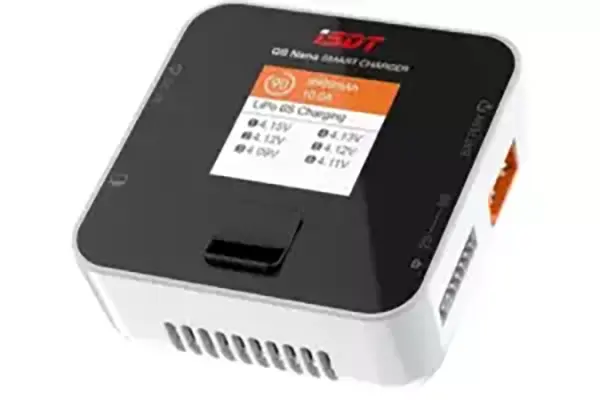
CHEAPEST WORTH HAVING
Although THE Q6 Nano only puts out 200 watts, that’s still more than enough to charge a typical FPV battery as fast as you could safely want. It could do a blistering 8C (unsafe!!!) charge rate on a 1000 mAH 6S battery. Or charge a massive 8000 mAh 6S battery in about an hour at a safe 1C. Frankly, it’s probably MORE charger than you actually need.
The Q6 Nano is surprisingly inexpensive, especially given that ISDT has a reputation for decent quality and reliability. You’d struggle to pay less for an off-brand charger that might or might not die as soon as you took it out of the box.
You know that thing where a charger charges really quickly until it gets to lke 90% and then grinds to a halt and takes forever to finish? The Q6 Nano only has a 0.5 amp balance current, so it will be slower to finish a charge cycle if the pack is out of balance, especially on very large and high cell-count batteries.
Another potential weakness of the Q6 Nano is that it can only charge a single battery at once. But given that it’s 1/2 to 1/3 the price of some other chargers on the list, you might just think it makes sense to buy a few.
Find this product at these vendors:
ISDT P30
30 AMPS / 1500 WATTS
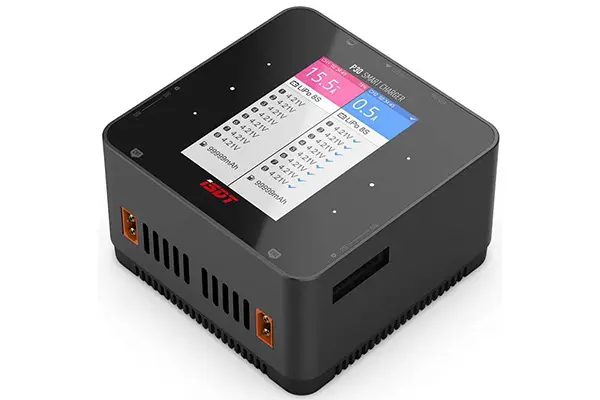
MORE POWER
Let’s be clear: this charge is overkill for almost everybody. But if you need to charge large CineLifter batteries, or if you parallel charge lots of packs at once, then you need a charger that can push lots of amps and lots of watts. This is it. The ISDT P30 can charge at 1500 watts maximum, or 1000 watts on a single channel, at up to 30 amps. And it can charge up to 8S LiPos if you’ve got any of those.
In addition to charging, the P30 can act as a DC power supply, from 2 to 30 volts with current limit from 1.0 to 5.0 amps. It won’t replace a proper bench supply, but it might come in handy.
Be aware that this charger requires higher input voltage to reach its full rated power. So you’ll want to look for a 24 volt, 1000 watt power supply if you intend to get the most out of it. The charger has a 60 amp input limit, which means you’ll get at most 720 watts out of it if you’re using a 12 volt power supply.
Find this product at these vendors:
HOTA F6
15 AMPS / 250 WATTS
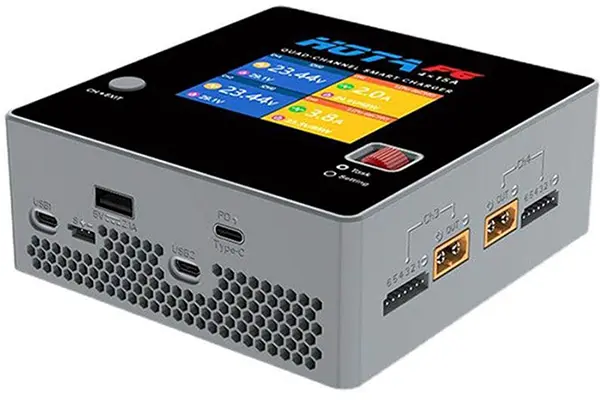
CHARGES 4 AT ONCE
The HOTA F6 stands out because it can charge up to four different batteries at a time. If you want to charge lots of packs and you don’t want to mess with parallel charging, this might be the one for you. It can output up to 15 amps and 250 watts per channel, simultaneously! Unlike other chargers that only output full power on one channel at a time, the F6’s rating is honest.
The F6 has a generous 1 amp balance current, which means it won’t bog down at the end of a charge cycle if your pack is not perfectly balanced.
The big question with the F6 is whether you’d rather buy four Q6 Nanos for nearly the same price. The specs on the Nano don’t quite match the F6, but either one is likely to be more than you need. If you were to buy four Q6 Nanos, you could easily stuff one in a pocket when running to the field. But if you wanted to charge four packs at once, the F6 would take less space than four Q6’s. It’s really a toss-up to be honest.
Find this product at these vendors:
The battery chargers above all require a separate power supply (PSU). They don’t plug into the wall. The PSU plugs into the wall and the charger plugs into the PSU. The advantage of this is that you save a bit of money (especially if you’re buying larger chargers). Another advantage is that if you upgrade your charger, you aren’t forced to pay for a new PSU at the same time. You can run your new charger off the old PSU.
On the other hand, having a separate PSU is a bit more cumbersome and complicated than buying a charger with an integrated power supply. If you don’t want to buy a separate PSU… if you want your battery charger to plug directly into the wall, the ones in this section are for you.
TOOLKITRC Q6AC
AC100Wx4 / DC 300Wx4 / 15Ax4
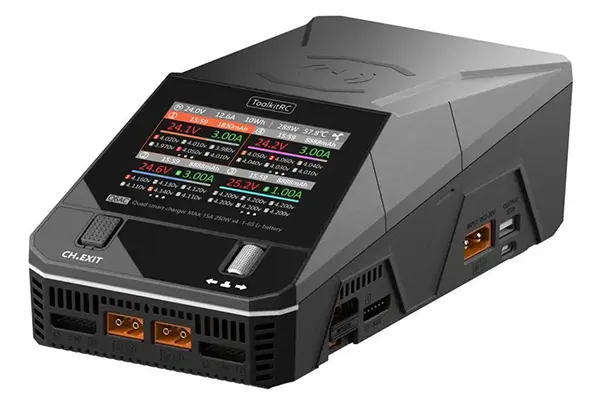
This charger comes strong out of the gate, but on closer look, it may be over-priced for its specs. It depends how much per-channel power you need.
Let’s start with the good: it can charge four separate batteries at the same time. It has both XT60 and XT30 connectors for two of the channels, so no adaptor needed to charge smaller packs. It’s got a wireless charging pad on top. And it can output 65W USB-PD (a lot of FPV pilots like to use this to power a portable soldering iron).
But the specs are less impressive. Yes, it can go up to 1200W (300W times four channels) but only when powered from an external DC power supply. When plugged into the wall and using its internal power supply, it only does 100W per channel. For perspective, that’s charging a 6S battery at about 4 amps.
By comparison, the HOTA F6+ is about the same price and its internal power supply can do up to 250W per channel (but only a total of 500W for the whole charger). So if you need to charge individual packs at over 100W, the F6+ might be a better choice. But if you’re ok with the 100W per-channel charging, the Q6AC might be the best choice.
Find this product at these vendors:
ISDT 608AC
50 WATTS AC/200 WATTS DC/0.1-8.0 AMPS
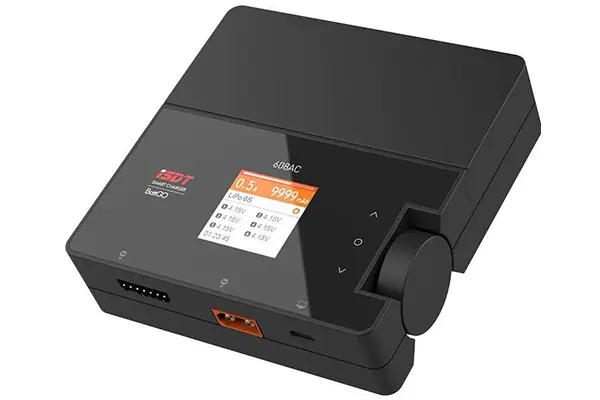
CHEAPEST WORTH HAVING
What if you didn’t have to decide between a bigger, heavier AC-input charger, and a lightweight, portable DC-input charger? That’s the point of the ISDT 608AC. It comes with a power supply that plugs into the wall (that’s the big thing hanging off the back). But you can easily detach the power supply and take just the charger with you, for charging off your car battery or another LiPo in the field.
The 608AC won’t win any awards for its output power: 60 watts and 8 amps is about what a beginner might need, but it’s not going to blast giant packs to full charge in the blink of an eye. That’s okay… beginners shouldn’t be blasting giant packs anyway.
Find this product at these vendors:
HOTA F6+
1000W DC / 500W AC / 15Ax4
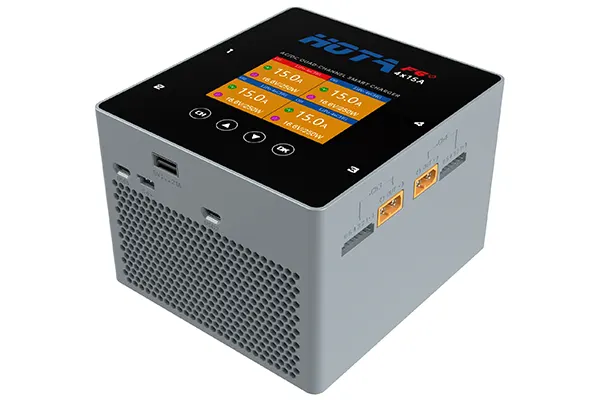
This charger is basically the HOTA F6, but with a built in 500W power supply. If you’re looking to charge four batteries at the same time, at up to 250W per channel, then … this charger can’t do that. Unless you connect it to an external 1000W DC power supply. Because its internal power supply is only rated for up to 500 watts. But it can charge four batteries at the same time at up to a combined 500 watts, and that’s nice.
Find this product at these vendors:
HOTA D6 PRO
15 AMPS / 325 WATTS DC
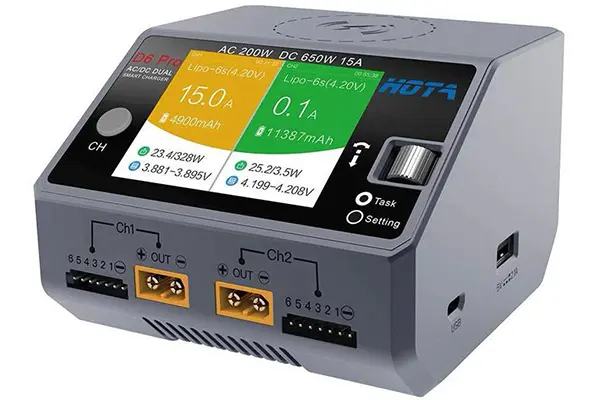
BEST ALL-ROUND
The original D6 Duo is reviewed below in the “AC/DC” section of this page. Ever since it came out, it has been my pick for best value, and it’s been my personal charger (there are three of them on my bench right now).
The only thing I didn’t like about the original D6 Duo is that it had a built in AC power supply. That’s fine if you need to plug it into the wall, but I already have a massive 1200 watt DC power supply. So the AC input of the D6 Duo was kind of wasted on me.
Hobbymate was listening. This version of the D6 Duo leaves out the AC input capability and knocks $50 off the price. That’s a clear winner to me. If you need a charger that can plug into the wall, get the AC/DC Duo. If you are going to use an external DC power supply, get this one, the DC-only version.
You may see this same charger listed under other names, such as HOTA and Turnigy Reaktor. These aren’t copies or clones. The original factory manufactures the exact same charger under different names. Whether the product listing says Hobbymate or HOTA, you can buy with confidence that you’re getting a legitimate product.
Find this product at these vendors:
HOTA S6
AC400W / DC325W X2
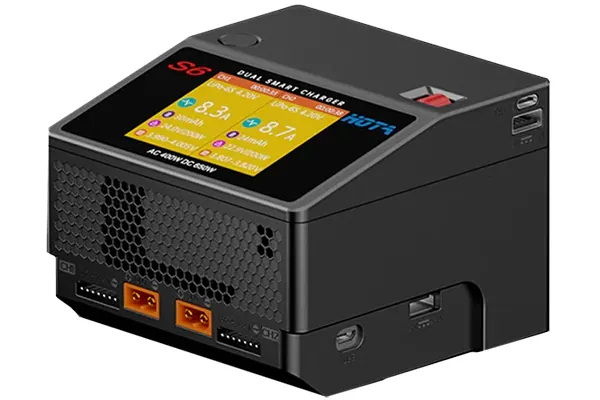
GIANT INTERNAL PSU
The HOTA D6 has been my personal favorite lipo charger for several years. So I’m thrilled that they’ve now released the S6, which is everything I loved about the D6, but even more power!
The D6 has a built in PSU that can run at 400 watts! It’s a massive amount of power especially given its small size. Compare to the ISDT K4, which has the same output (and costs $100 more). The D6 also has two USB 2A outputs and one 45 watt USB-C PD output.
The main question you have to ask if you’re considering the D6 is: do you really need this much power? If you’re only charging one or two typical FPV packs, you don’t. But if you charge very large packs for helis, planes, or cinelifters; or if you like to parallel charge 6-10 packs at a time, the HOTA S6 is the one for you.
Find this product at these vendors:
FIVE33 M6DAC
200 WATTS AC/DC
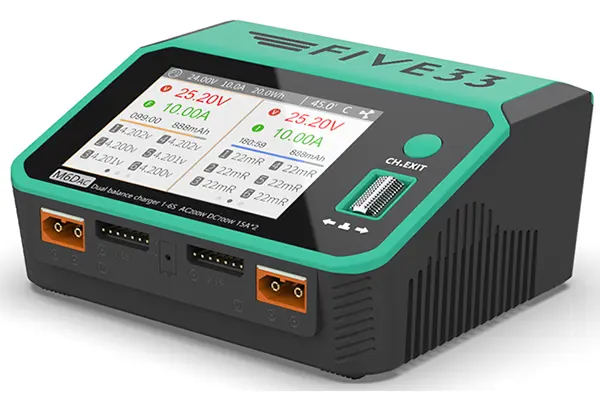
I have a love/hate relationship with ToolkitRC. Their chargers have great specs and features, and aren’t too expensive. But I’ve personally had several of them fail on my for no apparent reason, and I’ve heard similar reports from others, including one store who tested ten chargers they received for sale, and found all ten of them to be defective in some way. Based on this, I stopped showing ToolkitRC chargers on this site.
But when 533 partnered with ToolkitRC to make this M6D charger, I had to reconsider. Evan says that the M6D is the most popular charger at races, and has been solid for him and everyone he knows. Anything Evan Turner puts his name and his company’s reputation behind deserves consideration. So this is the ONE and ONLY ToolkitRC charger on this page.
The killer feature that makes this charger stand out is the Continuous Work mode. Select a charge program and hit go. Then as soon as you plug in a battery, the charger starts charging it. When it’s done, just un-plug and plug in the next battery whenever you’re ready. You never need to hit “go” or step through a menu.
Find this product at these vendors:
IMAXRC B3 PRO 2S / 3S
BALANCE CHARGER
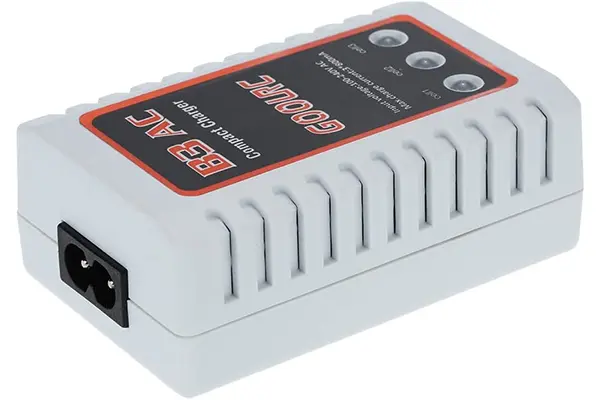
BEST FOR ACCESSORY PACKS
This charger solves one of the major annoyances of LiPo batteries: all the hassle that goes into actually charging them. Instead of fussing about with menus and buttons, the B3 charger simply plugs into the balance port of the battery.
Then it charges up the battery.
That’s it.
The place where this charger really shines is when charging up accessory packs like FatShark goggle batteries or a LiPo that you installed in your Taranis. These batteries usually don’t have the XT60 connector that your charger expects. With the B3 charger, you don’t have to dig around to find a lost adapter. Just plug it in to the battery’s balance plug and let it sit for a while.
I also love the B3 charger because it lets me top off my accessory packs without taking up an channel on my main charger. So I don’t have to wait for my Fatshark battery to finish charging before I start charging my flight packs.
The tradeoff of this convenience is that the B3 only works with 2S and 3S batteries, and it charges pretty slowly. At 800 mA charge rate, it would take about 2 hours to charge just one typical mini-quad battery.
Buy the B3 charger if you are looking for an inexpensive way to charge 2S and 3S LiPos–especially ones with non-XT60 connectors.
Find this product at these vendors:
Why do Tiny Whoop battery chargers get their own section? Can’t you charge Whoop batteries with a normal lipo charger? Yeah, you can. But big lipo charges are made to charge one or two big batteries with high output power. Whoop chargers are made to charge a four to six tiny batteries at a time, and high output power isn’t needed since the packs are so small. A Whoop charger can run all night from a modest USB power bank or LiPo battery. They’re small and easy to take with you. On top of this, Whoop chargers are typically not too expensive, so the convenience of having a dedicated charger for your Whoop packs is easy to take advantage of.
BETAFPV BT2.0 BATTERY CHARGER &
VOLTAGE TESTER V2
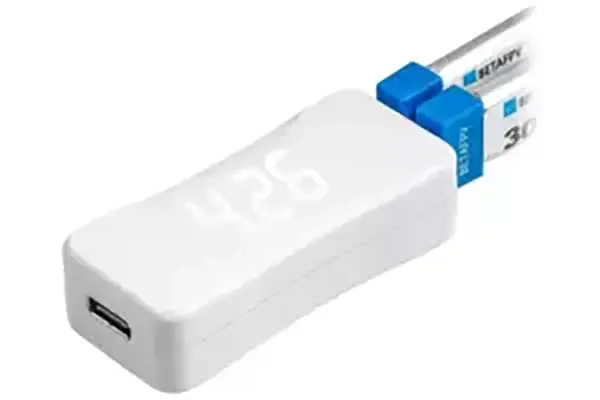
This is a handy little charger if you’ve got batteries with BT2.0 connector. It doubles as a checker and a charger, and plugs into any USB-C cable for power. The main limitation is that it only charges up to 2 packs at a time. If you really love this charger and you’re using packs with PH2.0 connector, you could always buy some adapter cables. This charger only charges to 4.35v for HV packs. Almost all Whoop packs are HV, but if you need standard lipo (4.20v) charging, this one’s not for you.
Find this product at these vendors:
VIFLY
WHOOPSTOR V3
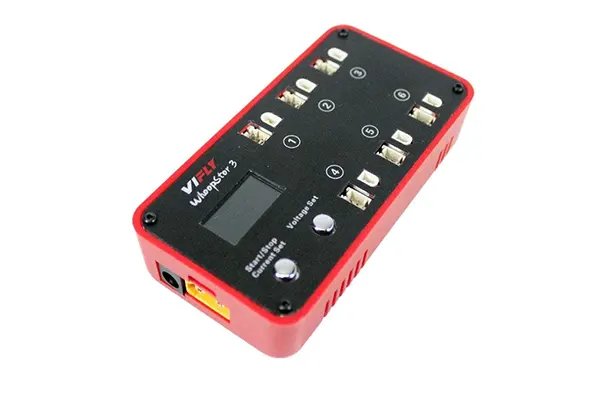
This is, hands down, my personal favorite Whoop battery charger today. It charges up to six packs at once. It can be powered off of USB-C, barrel plug, or XT60, so you can use your big flight packs (up to 6S voltage) to charge your Whoop packs if you’re away from power. It has both PH2.0 and BT2.0 plugs. It charges both standard lipo and HV lipos, but all ports must use the same type–no mixing. And it charges at up to 1.3 amps per channel, so you can hit 2C or even 3C on your batteries if you need to get up in the air quickly.
But the single feature that puts this charger over the top for me is that it has storage mode! Lipos hate being left at full charge or empty for long periods of time. Most lipo chargers have a storage mode, which puts the packs at a safe 3.8v / cell so they can be stored for a long time without damage. But Whoop chargers don’t have this. So your Whoop packs get left fully charged (or empty) and before you know it, they’re worn out. With the Whoopstor, you can put your Whoop packs to storage voltage, the same as you do with your larger packs, and extend their life.
Find this product at these vendors:
SERIES CHARGING BOARDS
FOR 1S WHOOP BATTERIES
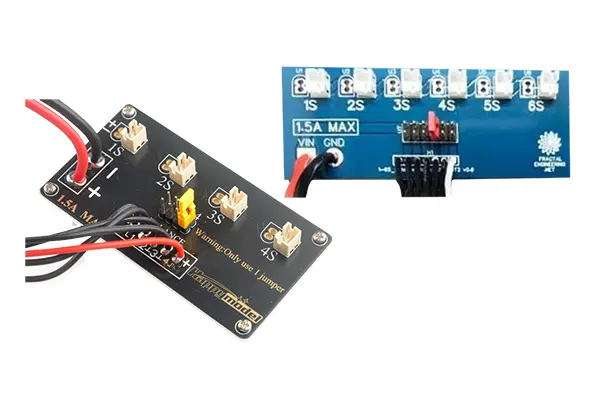
Let’s get one thing straight: These are NOT battery chargers. They’re series charging boards that let you easily charge your Whoop packs on your big-battery charger. Plug in your Whoop packs to the board. Plug the board into your charger as if it were a regular battery. The charger will auto-detect the number of “cells” (Whoop packs) plugged in, and then you can charge, discharge, and storage charge, just like normal. The charger will top off and balance the “cells”, and at the end of the cycle, you’ll be left with all the packs at whatever voltage you desire.
There are some quirks to this method, and many people prefer a simple set-and-forget dedicated Whoop battery charger. But these series boards offer functions like discharge and storage charge that most Whoop chargers leave out.
The Happymodel board supports only up to four packs at a time, while the Fractal Engineering board supports up to six.
The Fractal Engineering board sold at WeBleedFPV is the only one of these that comes with the BT2.0 plugs installed. The others have empty spots where you can solder your own BT2.0 plugs, but you have to source them and solder them yourself.
Find this product at these vendors:
Purchase at RaceDayQuads – Happymodel Board
Purchase at NewBeeDrone – Fractal Parallel Board
Purchase at weBLEEDfpv – Fractal Parallel Board
Purchase at Banggood – Happymodel Board
NEWBEEDRONE
NECTAR INJECTOR
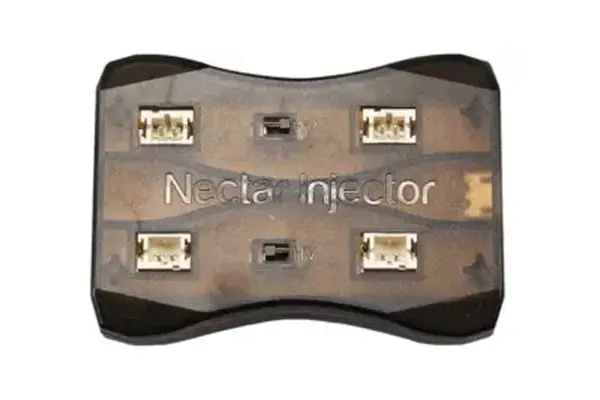
This charger charges up to four packs at once. Each bank of two ports can be separately set to HV or normal lipo charging, so you can mix cells if you need to. The charger will trickle charge cells that have been discharged too low, to bring them back to life. It’s powered from any 5v/2A USB source, via micro-USB plug. The charger has PH2.0 connectors, but can be used with BT2.0 batteries if you buy adapter cables.
Find this product at these vendors:
TINY WHOOP
STORAGE DISCHARGER
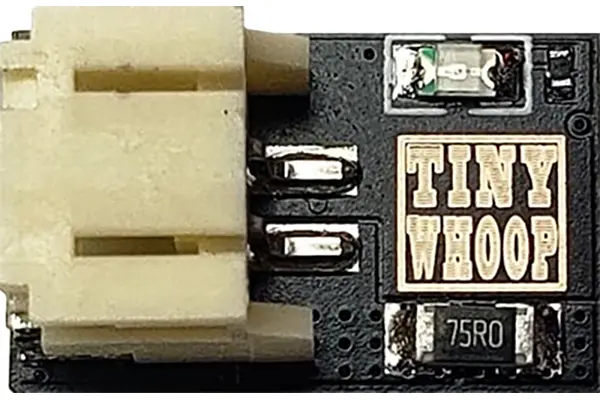
Leaving packs charged for a long period of time wears them out and makes them perform worse. Plug your Whoop packs into this little gadget and it’ll take them down to a safe 3.8v over the course of a couple of hours.
The main drawback of this device is its cost. You’ll want several to bring your packs down to storage in a reasonable amount of time, and by the time you’ve bought four or five, you could pick up the ViFly WhoopStor and have a more functional solution. But the tiny keychain size of the Tiny Whoop discharger is certainly appealing.
Find this product at these vendors:
If you’re buying a charger that comes with a built-in power supply (PSU), then you can skip this section. If you need a PSU to power your charger, it’s in this section. Here’s the bottom line when it comes to power supplies: you have to get a power supply that is as big or bigger than the watt rating of your charger. So if you have a 150-watt charger, you need a power supply rated at least 150 watts. If you buy a bigger power supply, there’s not much advantage except for future-proofing. Frankly, these are so reasonably priced that you should consider getting something in the 300 watt range even if you’re only buying a small charger today.
One more thing! Most people will not get the full rated output power of their charger if they are running off of 12 volts! Here’s a video I made about that. The short version is that most people should use a 24 volt power supply, and yeah I’ve got a link to one.
24 VOLTS / 400 WATTS
POWER SUPPLY
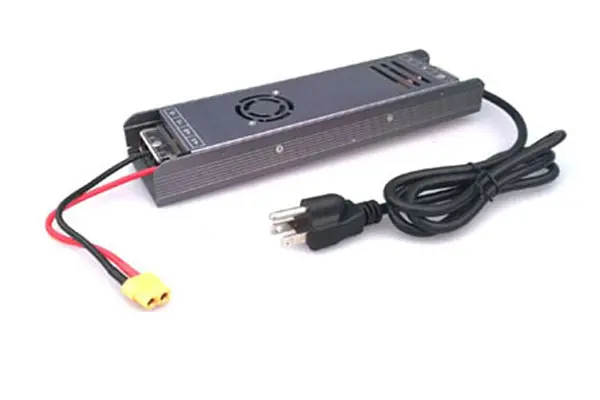
If your charger is rated for more than about 170 watts, then you probably need to feed it more than 12 volts, or you won’t actually get the full rated output power. What sets this power supply apart from the others on the list is that it outputs 24 volts. And it’s super affordable. And it’s got a 3 year warranty. So yeah. Basically, if you don’t know which power supply to get, get this one.
Find this product at these vendors:
12 VOLTS / 360 WATTS
POWER SUPPLY
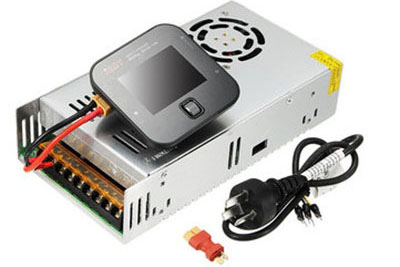
This power supply can power all of the chargers on this list. It includes an adapter plug for the iSDT charger. The photo shows a European-style plug, but the PSU comes with a plug adapter for the country of delivery, so no worries there.
Find this product at these vendors:
12 VOLTS / 750 WATTS
HP POWER SUPPLY
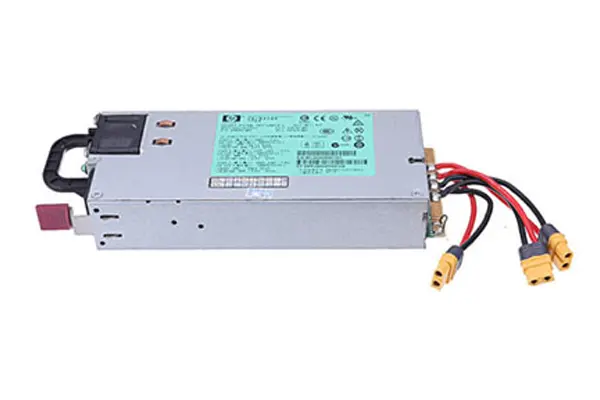
This power supply was originally designed for a rack-mount server, not a LiPo charger. But hey! 12 volts is 12 volts, right?
Here’s why it’s awesome:
-
It puts out up to 1200 watts. Way more than most of us are ever going to need.
-
It’s not some cheap POS slapped together in China for pennies. This PSU is legitimately intended to run in a production environment. It’s got top-quality hardware and engineering. It’s got short-circuit protection. It’s got thermal protection. It’s the best.
-
It costs between $20 and $40 depending on the size. You can easily pay more than this for a “cheap” PSU with half the capacity.
It used to be that if you wanted this good of a deal, you had to do some soldering on the PSU to get it to work. But now Banggood has done that work for you! So the only reason to hesitate is the long shipping time.
You can still purchase this same PSU on Amazon or eBay and mod it yourself if you don’t want to buy from Banggood.
Find this product at these vendors:
The advantage of parallel charging is that it lets you charge many small batteries quickly. Since mini quad pilots use a lot of small batteries, parallel charging is a big help. But parallel charging carries significant risks, and you should absolutely not use a parallel charging board unless you understand the risks and are capable of following the safety procedures. Here’s a video showing my safety procedures, but you must do your own research and not just rely on this one video.
The main risk of using a parallel charge board is that you can cause a battery to explode. Watch this video. This is no joke. A secondary risk is that if you have one damaged battery, it can damage other healthy batteries if they are plugged in together on a parallel charge board.
STRIX ULTIMATE PARALLEL
CHARING BOARD 2-6S
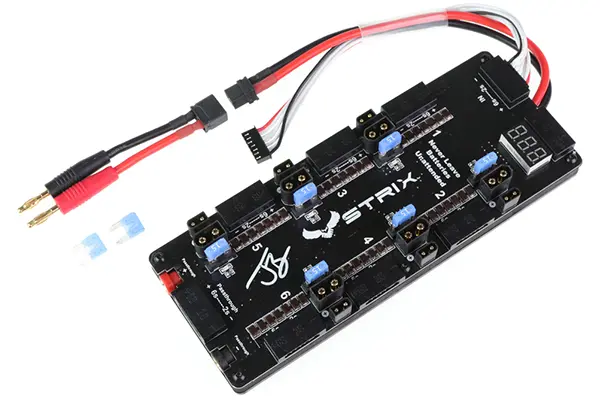
“JB SIGNATURE LINE”
THE BEST (IN MY HUMBLE OPINION)
I worked with ReadyMadeRC to design this parallel charge board to my specifications. I think it’s the best value parallel charge board available.
The biggest mistake people make with parallel charge boards is to plug in two batteries with too much voltage difference between them. This causes massive current to flow between them and typically destroys the parallel charge board or even causes the battery to blow up! This board protects against this by including fuses on both the XT60 connectors and the balance plugs. The XT60 fuses are automotive-style; the balance plug fuses are auto-resetting polyfuses.
The board includes both XT30 and XT60 plugs, and support batteries from 2S to 6S voltage. It’s got a separate cell checker so you can be sure your batteries are at a safe voltage before plugging in.
For more, check out my video review of this board.
Find this product at these vendors:
XT60 PLUG PARALLEL
CHARGING BOARD
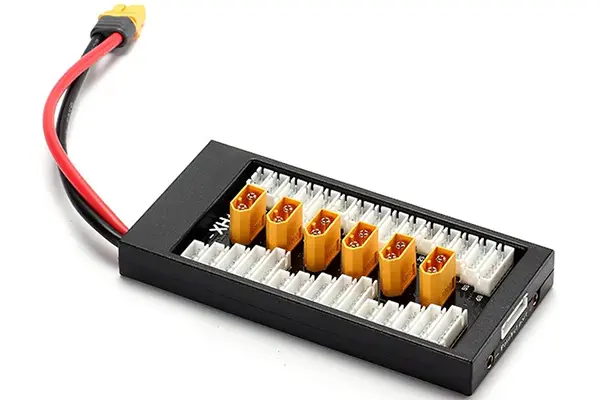
CHEAPEST WORTH HAVING
Until I came out with the “JB Signature Line” board, this was all I used. Although this board seems cheaper at first, the “JB Signature Line” board has 10 ports compared to this one’s 6. The “JB” board also has fuses for additional safety. But if you need to save every last dollar, this board does come in at a lower dollar amount.
The main reason you would choose this board is if you need to charge a variety of cell voltages other than 4S. This board can take any balance plug from 2S up to 6S.
The product linked above has an XT60 connector on it, which makes it compatible with the iSDT chargers above. The other chargers take banana plugs, in which case this is the one you want.
Find this product at these vendors:
LUMENIER
PARAGUARD PRO
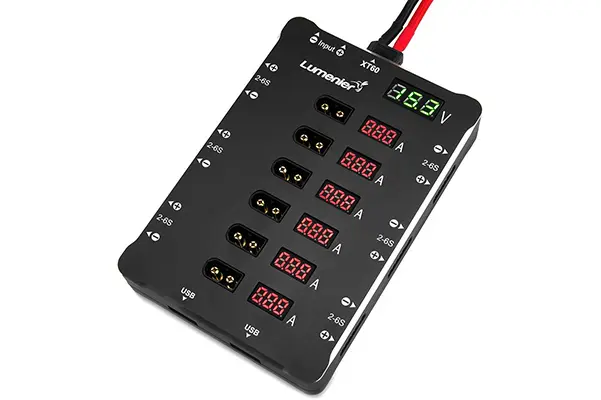
SAFE PARALLEL CHARGING BOARD (XT-60 – 6 PORT)
Finally, somebody takes parallel charging as seriously as I do! In fact, Lumenier might have beat me at my own game with their ParaGuard parallel charge board. It’s got balance plugs that can accept 2S to 6S batteries. It’s got polyufuses to protect against short circuits. It’s even got individual voltage readouts for each battery.
Find this product at these vendors:
There’s always a risk of LiPo batteries catching fire. The risk is highest when charging packs, but even packs resting a storage voltage can ignite, especially if they were damaged in a crash. And LiPo fires are particularly dangerous because they’re self-oxidizing. They don’t need supplemental oxygen to burn. You can’t put them out with water and you can’t suffocate them. The only thing you can do is contain the flames until the pack burns itself out, and try to prevent or contain secondary fires.
BAT SAFE
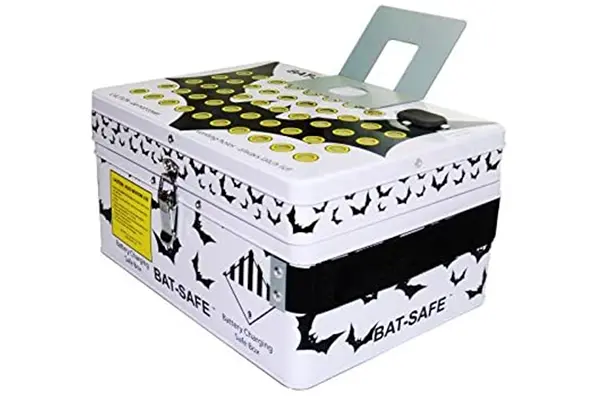
SAFEST LIPO STORAGE
Bat-Safe is the absolute top of the line in LiPo storage. It’s got insulated walls to protect nearby surfaces from heat. Vent holes have filters, so that the smoke from the fire contains fewer harmful components (less smell and cleanup after the fire). In addition, it’s got a pass-through hole and a mounting bracket for your charger so that you can safely charge inside the box with your charger on the outside.
Bat-Safe boxes aren’t cheap. But they are the single best form of protection against fire and smoke damage that’s available in the RC hobby. That leaves the question: which size should you get? We actually don’t prefer the XL version, as it’s so deep that it can be difficult to get packs in and out. The main reason to get the XL would be if you had particularly large packs. But if you’re thinking of stuffing it full of a bunch of small packs, just get two or three of the medium size. The small size could be useful if you only intend to use the box for charging of a single pack, and not for storage of all your packs.
Find this product at these vendors:
A battery checker is more than just a convenience, it’s an essential safety tool. The number one way you can damage a LiPo is by discharging it too much. You can even lose your quad if you accidentally try to fly on a battery that you already discharged. If you use a parallel charge board, it’s absolutely mandatory to check the state-of-charge of every battery before you plug it in.
HOBBYPORTER MC06
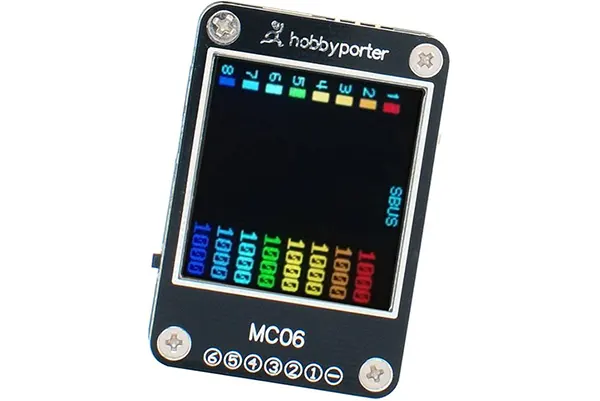
CHEAPEST WORTH HAVING
If you’re looking for a simple battery checker, with no frills, the MC06 should be your choice. As far as checking voltage goes, it’s got similar functionality to the ISDT BG-8S, but at 1/3 the price! The BG-8S has additional features like USB power output and the ability to (very slowly) balance cells. How often are you going to even use that? And the MC06 is smaller and more pocketable.
Don’t get me wrong! I love my BG-8S, but if the MC06 had been around 2 years ago, I would probably own it instead of the BG-8S, and have a lot more cash in my pocket. One major limitation of this checker is that its OLED screen is not easily viewable in bright sunshine.
Find this product at these vendors:
ISDT BG-8S SMART BATTERY CHECKER
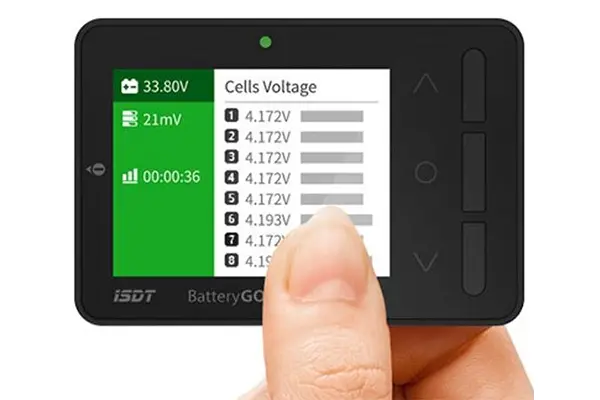
TOP OF THE LINE
With its full-color OLED screen, the BG-8S is the prettiest battery checker you ever saw. But it’s way more than that. Plug in a LiPo, and it’ll double as a USB charger. (And it supports Qualcom Quick-charge too!) As if that’s not enough, it’s an RC signal analyzer.
Let me tell you why that’s so cool. Imagine your flight controller isn’t receiving signals from your receiver. In the old days, you would just plug a servo into the receiver and the position of the servo would indicate what signal was coming out. Modern receivers output PPM or serial protocols, and those don’t work with servos. That’s where the BG-8S comes in! Its built-in signal analyzer will show you what your PPM or SBUS receiver is outputting so you can troubleshoot why your flight controller isn’t working properly.
Find this product at these vendors:
VIFLY STORESAFE
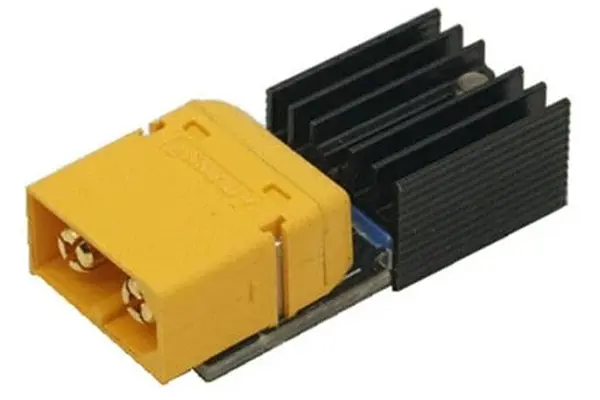
EASY STORAGE CHARGING
LiPo batteries slowly lose performance if they’re left at full charge or fully empty. For the longest lifespan, they need to be stored at 3.8 volts per cell. All of the chargers on this page have a Storage program that brings packs down to this voltage. But if plugging in to a charger is too much hassle, consider the ViFly StoreSafe. It’s a tiny device that plugs into your battery to slowly and safely discharge the pack to 3.8 volts.
The StoreSafe has a few drawbacks. First, it can only discharge the pack. This is great if you finish a day of flying with a bunch of fully charged packs. But if you’ve got a bunch of empty packs, you’ll still need a charger to bring them up to 3.8 volts. Second, the StoreSafe doesn’t balance the cells. So there’s some chance you’ll end up with one cell a little higher than 3.8 volts and one a little lower. Practically speaking, this probably won’t matter, but if you really care, you’ll use a regular charger to balance the cells as part of the storage process.
Find this product at these vendors:
USB-C TO XT60 ADAPTER CABLE
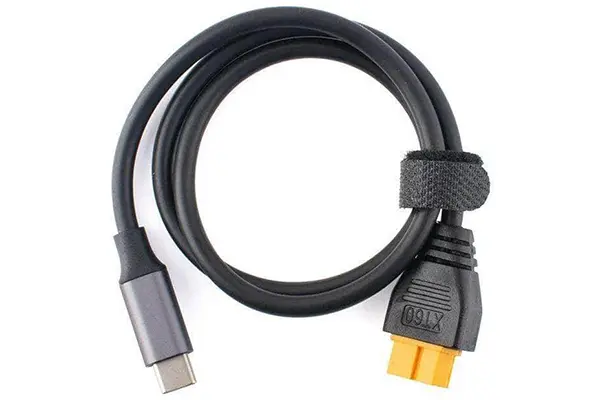
Let’s say you’ve got a lipo charger that you want to power in the field. Most people would run it off a big lipo battery or maybe plug it into their car’s battery. But what if you have a USB power bank? That’s what this cable is for. It tells your USB power bank to output the highest voltage it supports (up to 20 volts) and puts it out on the XT60 as a DC voltage for your charger to use.
There are a few gotchas you should be aware of. The USB power bank needs to support USB-PD (power delivery). And it needs to be able to output enough watts to run the charger at whatever charging rate you like to use. Also: a typical lipo battery for a 5″ quad is about 22 watt-hours. Most USB power banks are 1S voltage internally, which means you’ll need a 6000 mAh power bank just to charge up ONE lipo battery.
All of that means that this cable is only going to be the right solution for a specific person, but if you’re that person, here it is!
Find this product at these vendors:



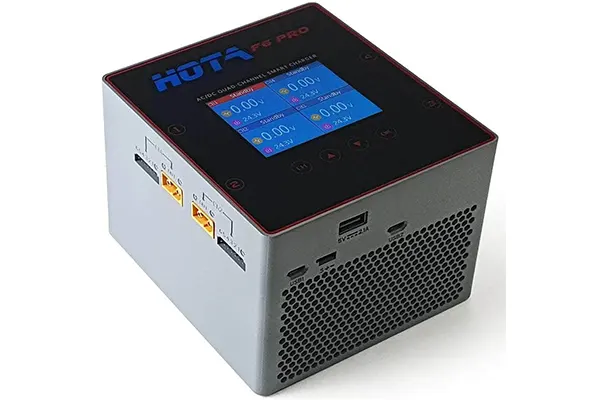
Every other AC/DC charger on this page has an under-sized built-in power supply that means it doesn’t make its full rated power unless you plug it into an external DC power supply. So that “1000 watt” charger? Actually only makes 500 watts!
IF I WANTED TO USE AN EXTERNAL POWER SUPPLY, I WOULDN’T HAVE BOUGHT A LIPO CHARGER THAT PLUGS INTO THE WALL!
This is the ONLY lipo charger I’ve ever seen that has the exact same output power when used on AC input as when used on DC input. It says it outputs 720 watts. It outputs 720 watts. No external power supply needed.
So who cares? Well … people who need to output 720 watts and who don’t have a separate high-powered DC power supply. But hang on. Because this charger is also the most expensive single charger on this page. So if you can get by with the lower power rating of the other chargers, or if you have an external DC power supply, then get something else.